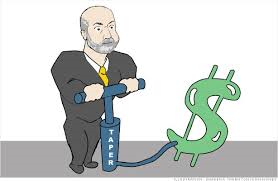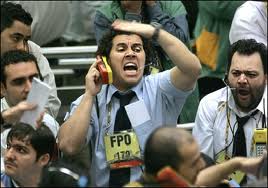By perfectly calibrating his message, this time, Bernanke was able to taper yet see equities climb by 1.75% and bond prices barely budge. Quite a difference from this past May. By combining tapering with a commitment to keep short-term rates low into 2015, Bernanke has reduced uncertainty and compensated markets for the knowledge that QE will shortly be history. He’s also emphatically saying that 2014 will be pretty good. Bravo!
Tag Archives: QE3
Quantitative Easing
QE is not “printing money” as it does not increase the amount of money in circulation. Handing out $100 bills would be printing money. By purchasing Treasuries and MBS, the Fed raises the price of those securities and thus lowers interest rates. And lower rates can certainly result in an increased desire to borrow. But that increased demand will only lead to money supply growth if private banks make loans.
Federal Reserve Flexibility
The just-released minutes of the Federal Reserve’s July meeting are a Rorschach test. For those reluctant to taper, there’s a nod to the still struggling labor market and the very low inflation rate. Conversely, others felt that the recent rise in interest rates would exert little restraint and that easier lending standards would help juice the economy. Unless the August employment numbers are gangbusters, I expect no September tapering.
Interesting Jobs
With 195,000 new jobs in June, the average monthly gain in the first half of 2013 is 202,000 – way up from the 130,000/month pace when QE3 began. Moreover, the unemployment rate remained unchanged, because 177,000 people joined the labor force! Unfortunately, 112,000 of the new jobs were either in leisure and hospitality or retail trade, both low-paying sectors. Three more months like this and tapering probably starts in September.
Vicious Volatility
On days like today when stocks, bonds, precious metals, commodities and emerging markets all fall, portfolio diversification, doesn’t help. Remember that. Separately, financial markets have wiped out all of May and June’s gains not because QE3 will end, but because participants are unconvinced that the economy can withstand higher interest rates without slowing. And that will hurt household spending and ultimately corporate earnings. I’m diversifying into booze.
Fractious Fed
With the Fed (and everyone else) forecasting improved economic conditions in the second half of ’13, it’s not surprising that the Fed again reiterated that it MAY start tapering QE3 later this year. Interestingly, the Fed has been consistently over-optimistic when it comes to forecasting. Thus, I still think tapering commences no earlier than November. But, if monthly job creation numbers stay above 183,000/month, tapering could commence in September.
More Mediocrity
The good: the index of leading economic indicators rose, as did retail sales, consumer sentiment, and housing permits. The bad: Europe is now officially in recession, first-time unemployment claims rose, manufacturing activity declined, inflation as measured four different ways is non-existent, housing starts weakened, and industrial production and capacity utilization both fell more than expected. Data like this is why talk of tapering QE3 before January 2014 is exceptionally unlikely.
Bernanke Boost
While the economy is hardly roaring, Q3 GDP growth will be 2%, which is pretty good compared to month or two ago when 1.5% is what I would have predicted. Moreover, QE3 should boost Q4 GDP. That’s because the promise of massively stimulative monetary policy for the forseeable future, is suppressing interest rate increases in the face of good news (falling unemployment, and good retail sales), making investors happy.
Currency Clash
When the Fed announces a third round of quantitative easing, expect unintended cross-currency consequences. Last time, the dollar fell against a host of currencies, but now central banks in many of those same countries will actively intervene to prevent their currencies from appreciating against the greenback. However, other countries seem unprepared to intervene such as Australia, New Zealand and South Korea. As a result, bet on their currencies rising.
QE3 Despite Drought
Despite inevitably higher food prices starting this fall, stemming from a severe drought, the Fed will ignore this when they launch a third round of Quantitative Easing in September. It’s because the drought is a short-term event that will probably reverse itself in ‘13. Moreover, groceries are barely 7% of the average family budget, and since wages are not tied to inflation this price rise won’t become permanent.









